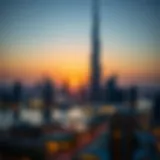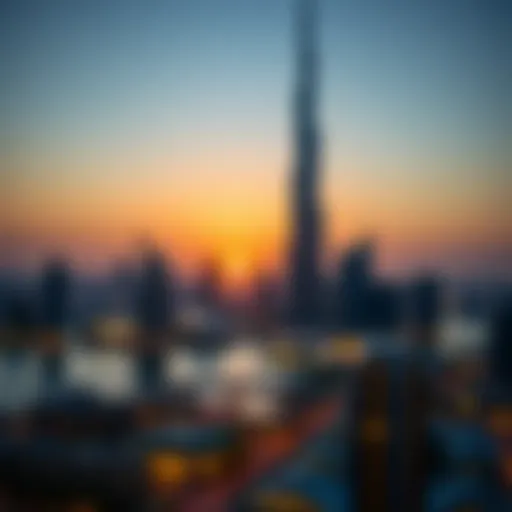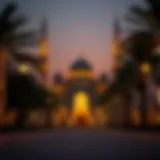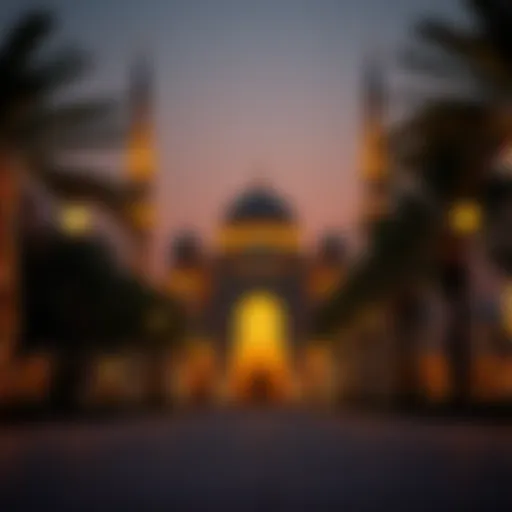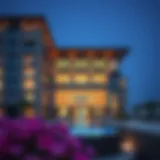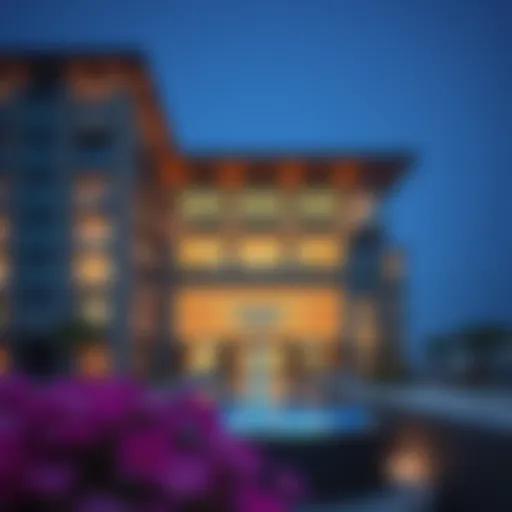Explore the Dubai Metro Green Line Stations Features
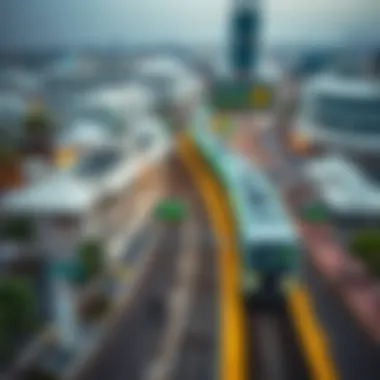

Intro
In the bustling metropolis of Dubai, the Metro Green Line serves as a vital artery for both residents and visitors alike. This section of the Metro system not only eases the commuting burden but also showcases how urban planning effectively integrates transportation with everyday life. This exploration of the Dubai Metro Green Line stations aims to illuminate the features and accessibility of each station, along with the surrounding neighborhoods.
Dubai's innovative approach to public transport has influenced real estate developments significantly. Proximity to a Metro station not only provides convenience but also enhances property values, creating a subtle yet transformative ripple through the housing market. Investors, realtors, and homebuyers alike will find that understanding these dynamics is essential for informed decision-making.
As we delve into the features each station offers, it's crucial to note how they connect various parts of the city. This facilitated movement not only appears in charts or graphs but is felt in the everyday experiences of those who navigate this vibrant urban landscape. From shopping hubs to educational institutions, each station acts as a nexus, linking people with opportunities.
By the end of this article, readers will emerge with a comprehensive insight into the Green Line's stations and their impact on real estate trends, empowering them to make choices that align with their goals and ambitions in this ever-evolving city.
Market Trends and Insights
Current Market Analysis
The current state of the Dubai real estate market is influenced heavily by its surrounding infrastructure, particularly the Metro system. The Metro Green Line's expansions have led to not only increased foot traffic but also heightened interest from potential buyers or renters looking to live near such convenience.
Key features of the market include:
- Rising residential demand near metro stations.
- Increased prices for real estate in proximity to transit hubs.
- Greater interest from international investors as the city gains more worldwide recognition.
Furthermore, many buyers lean towards properties that promise not just luxury but also practicality. The reality is clear; properties near a Metro station often see quicker sales and reduced time on the market, creating a sense of urgency among buyers.
Historical Trends and Future Predictions
Historically, the launch of the Green Line revitalized areas that previously had lower visibility in the real estate market. As stations opened, surrounding land saw a dramatic increase in development.
Looking forward, analysis suggests:
- Sustainably built mixed-use developments will likely rise near key stations.
- Property values are expected to increase over time as the city expands.
- Future transport projects may further push innovation and housing solutions.
These trends present a unique opportunity for investors looking to capitalize on the growth of areas adjacent to the Green Line. The combination of transit-oriented development and careful urban planning creates a recipe for a thriving real estate environment.
Preamble to the Dubai Metro Network
The Dubai Metro is not just a mode of transport; it represents a pivotal shift in urban mobility in the UAE’s bustling metropolis. As Dubai has evolved into a global hub for business, tourism, and culture, the metro system has become the lifeblood that ensures seamless connectivity across various districts. In this article, we’ll take a closer look at the network, laying out the historical context and specifics of the Green Line. This will grant readers insight into how this development has enabled a smoother commuting experience for residents and visitors alike.
The importance of the metro network lies in its capacity to ease traffic congestion, reduce carbon emissions, and promote sustainable urban living. While many urban areas struggle with heavy reliance on personal vehicles, Dubai has taken bold steps to integrate public transport into its city planning. Today, the metro boasts over 75 kilometers of tracks with multiple lines, playing a crucial role in connecting key areas and ensuring efficient transport.
History of the Dubai Metro
The roots of the Dubai Metro can be traced back to the early 2000s when the Dubai government recognized the need for a sophisticated public transport system. The construction kicked off in 2006, with the first phase officially launched in September 2009. Initial skepticism from citizens and expats about its necessity quickly transformed into enthusiasm, as the metro soon proved to be an efficient alternative to the roadways.
From a modest start, the Dubai Metro has seen remarkable growth, with an expansion project underway, increasing its capability to accommodate the ever-growing population and influx of tourists. It’s important to acknowledge that the metro was not just built to ease travel; it was also designed to accommodate the spectacle of Expo 2020, drawing visitors from all corners of the globe.
Overview of the Green Line
The Green Line is one of the major arteries of the Dubai Metro system. Stretching from Al Ghusais to Dubai Creek, it provides essential access to various key destinations. What stands out about the Green Line is its strategic positioning; unlike its counterpart, the Red Line, which runs primarily through business hubs and tourist hotspots, the Green Line connects residential areas, local markets, and vital healthcare facilities.
Key Features of the Green Line:
- The line stretches approximately 22.5 kilometers and includes 18 stations.
- Designed to service a diverse range of neighborhoods, it allows better access to local amenities.
- Significant stops include Dubai Healthcare City and Burj Khalifa/Dubai Mall stations, which draw a high volume of commuters daily.
"The Green Line connects both traditional and modern aspects of Dubai, underscoring the city’s commitment to providing comprehensive transport solutions."
This overview of the Green Line sets the stage for a deeper exploration into each station, focusing on their unique features and surroundings in the following sections. Understanding this space helps investors and developers identify opportunities around rapidly growing areas, fostering healthier real estate prospects and urban development.
Significance of the Green Line
The Green Line of the Dubai Metro is nothing short of a vital artery within the bustling metropolis of Dubai. Its significance cannot be overstated, as it connects key neighborhoods and commercial districts, streamlining transport within the city. As an extension of the already impactful metro network, the Green Line enhances both mobility and accessibility. The integration of this line has made it increasingly easier for commuters and tourists alike to navigate the city, promoting greater convenience in daily life and reducing the reliance on private vehicles. Moreover, the route fosters economic growth by linking residential areas with major business hubs, thereby driving foot traffic where it matters most.
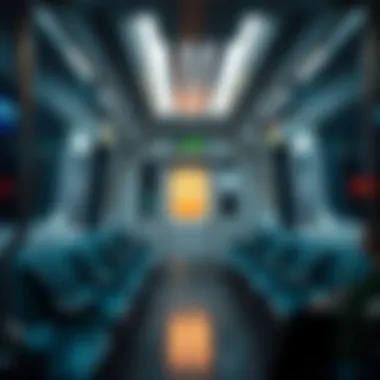

Connecting Key Areas of Dubai
The Green Line links some of the most important areas of Dubai, effectively serving as a bridge between diverse neighborhoods. Stations such as Al Ghusais and Al Nahda offer easy access to residential comforts, while areas like Al Rigga and Union cater to the commercial needs of the city. Consider for a moment, the ease with which a resident of Al Nahda can traverse to the Dubai Healthcare City Station; cutting down not only travel time but contributing positively to one’s work-life balance.
Additionally, the Green Line plays a crucial role in connecting cultural and recreational spaces. The Burj Khalifa/Dubai Mall Station, for instance, positions travelers right at the foot of the world’s tallest building and adjacent to one of the largest shopping destinations globally. It’s a convenient launchpad for both tourists and locals wanting to indulge in leisure activities without the hassle of parking in congested spots.
This centrality in location underscores the Green Line’s importance in the urban framework of Dubai. As a hub for moving people around, it also supports local businesses by facilitating customer access, thus creating a ripple effect that enhances local economies around each station.
Impact on Real Estate Development
The influence of the Green Line on real estate development cannot be ignored. Proximity to a metro station increasingly becomes a determining factor for homebuyers and investors. Properties adjacent to Green Line stations often see enhanced market value, making them hot commodities in the real estate landscape. People want convenience; being a stone’s throw from a metro station adds tremendous appeal.
This uptick in interest is not merely anecdotal. Various studies have indicated that property values near metro lines typically appreciate faster than those that are farther away. For instance, looking at the developments near the Dubai Healthcare City Station, it's evident that new residential complexes are rapidly cropping up, with developers keen to capitalize on this accessibility. No wonder there’s a buzz surrounding these areas.
"Metro stations act as catalysts for economic growth, leading to increased property values as well as an infusion of new businesses."
Investors eye these stations with intent, knowing the potential for rental income rises as accessibility improves. Furthermore, with ongoing developments, neighborhoods previously considered less prime are transforming into sought-after locales due to improved connectivity.
In summary, the Green Line has intertwined residential interests with commercial aspirations, reshaping the way Dubai's landscape is navigated and enhanced. Its significance not only lies in connecting areas but also shaping future real estate developments, making it a cornerstone of the city’s growth and evolution.
List of Green Line Stations
The Green Line serves as a vital artery within the Dubai Metro system, connecting various neighborhoods, commercial hubs, and key landmarks. Understanding the significance of each station along this line provides valuable insights for investors, realtors, homebuyers, developers, and analysts alike. This section outlines the various stations on the Green Line, highlighting their unique features and the advantages they offer.
Al Ghusais Station
Nestled in the eastern part of the city, Al Ghusais Station is a linchpin for residents and workers alike. It is surrounded by an array of apartment buildings, making it popular with families and expatriates. The station is strategically located near important landmarks, such as shopping areas and schools, enhancing its appeal for both tenants and homebuyers. With reliable connectivity to key destinations, this station ensures that commuting is hassle-free.
Al Nahda Station
Al Nahda Station, one of the bustling stops along the Green Line, caters to a diverse population. A short walk away, visitors can find various retail choices and eateries that reflect Dubai's multicultural society. This locale also connects with residential sectors, providing easy access to amenities that enhance quality of life. Yeah, it’s this grassroots connectivity that positions Al Nahda as a crucial player in Dubai's urban fabric.
Stadium Station
Stadium Station is named after the nearby sports complex and is a hotspot during sporting events. Its proximity to the Al Ahli Club makes it a common transit point for sports enthusiasts. Not just for sporting fans, it's surrounded by various entertainment options, generating substantial foot traffic. This station stands as an excellent opportunity for businesses looking to capitalize on event-driven influxes.
Al Rigga Station
Al Rigga Station thrives in the vibrant heart of Deira, known for its lively atmosphere and rich culture. The station opens doors to bustling markets and traditional souks, making it a prime destination for both tourists and locals. For real estate investors, the station's location presents a compelling case for surrounding commercial developments aimed at exploiting touristic footfall.
Baniyas Square Station
Sitting at a critical junction, Baniyas Square Station intersects multiple metro lines, elevating its status as a central hub for commuters. The surrounding area hosts several governmental offices and financial institutions, making it valuable for business travelers. Moreover, its accessibility supports local commerce, leading to a more dynamic neighborhood.
Union Station
Union Station is unforgettable, often serving as the nerve center for tourists exploring Dubai. As a connecting point between the Red and Green lines, it attracts a diverse audience. Adjacent shopping malls and recreational facilities add a layer of convenience and leisure, which is particularly appealing for families. The real estate landscape around Union is constantly evolving, driven by consumer demand for mixed-use developments.
BurJuman Station
BurJuman Station branches off into a large shopping hub, complemented by luxury shopping and casual dining. It serves as a key destination not just for locals but also for visitors. Properties nearby attract premium pricing due to their proximity to retail and transportation. Analytics reveal consistent growth trends for the neighborhoods surrounding BurJuman, marking it as a prime investment area.
Dubai Healthcare City Station
Health and wellness have become intertwined with lifestyle in today’s Dubai, and Dubai Healthcare City Station is a perfect showcase of this trend. The station provides access to advanced medical facilities and wellness centers, appealing to healthcare professionals and patients alike. Investors might find opportunities here particularly lucrative as the healthcare sector continues to expand.
Oud Metha Station
Oud Metha Station is a stepping stone to both residential and commercial establishments. Schools and parks nearby are key selling points for families considering property in the area. The appeal of community-oriented living is palpable here, offering potential for residential developers to fill gaps in the market.
General Hospital Station
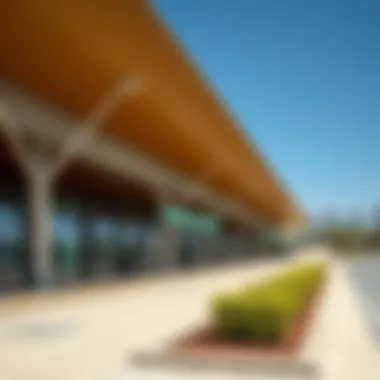

As the name suggests, this station caters to both patients and healthcare workers frequenting the General Hospital nearby. Given the increasing demand for healthcare services, properties in this vicinity tend to show resilience in value. Future developments may align with this trend, making it crucial for analysts to pay attention.
Al Jafiliya Station
In the cultural melting pot of Dubai, Al Jafiliya Station is enveloped by art galleries and historical sites. This cultural touchstone makes it attractive for those interested in urban renewal projects. The intertwining of art and transportation adds unique opportunities for investors looking at thematic developments.
Emirates Towers Station
Positioned near the world-renowned Emirates Towers, this station serves as a beacon for business travelers seeking luxury. High-end hotels, corporate offices, and chic restaurants mark this area. Its appeal lies not just in transportation but also in the upscale lifestyle that surrounds it, providing ample opportunities for premium investment returns.
Financial Centre Station
Financial Centre Station embodies the essence of Dubai's business acumen, catering primarily to corporate executives. The station's proximity to financial districts means bustling weekdays and calming weekends for the surrounding neighborhoods. As businesses continue to flourish, the demand for real estate in the area is projected to stay strong.
Burj Khalifa/Dubai Mall Station
This iconic station operates at the core of Dubai's tourism hub, situated close to the Burj Khalifa and the Dubai Mall. With such world-famous landmarks, it sees heavy foot traffic. The commercial opportunities here are vast, from retail to hospitality. For real estate professionals, it's hard to overstate the value of being near such high-traffic areas.
Business Bay Station
Business Bay Station connects one of the busiest business districts in Dubai, featuring glitzy skyscrapers and urban amenities. This area is continuously evolving, providing a fertile ground for investment in office spaces. In short, the future is bright for developers focusing on this emerging central business area.
Al Safa Station
Al Safa Station is uniquely positioned, providing access to both residential enclaves and green parks. Its charm lies in being a bridge between the urban hustle and calm leisure spaces. Investors looking for properties close to nature and family-friendly amenities will find this area particularly interesting.
Understanding the Green Line stations equips investors, realtors, and homebuyers with the insights necessary to navigate Dubai's rich urban fabric. Proximity to these stations not only affects accessibility but also has tangible impacts on property values and market trends.
Accessibility and Connectivity
The accessibility and connectivity of the Dubai Metro Green Line is not just a matter of convenience; it's a lifeline for many residents and visitors alike. This aspect of the Metro enhances the mobility of individuals, allowing them to navigate the sprawling urban landscape with ease. With a structured framework of efficient transport options and key interchange stations, this network significantly reduces travel time and improves the overall experience for commuters.
The Green Line serves as a crucial segment, linking various districts that would otherwise be disconnected, thereby promoting a seamless transportation experience across Dubai. The direct connection to critical business hubs, educational institutions, and residential areas bolsters not only daily commuting but also fosters economic growth. By being able to access vital locations quickly, individuals can save precious time, which is especially valuable in a bustling metropolis like Dubai.
Interchange Stations
Interchange stations on the Green Line are significant nodes in the Metro system, acting as gateways that facilitate transfers between different lines. One such pivotal point is the Union Station, which connects the Green Line with the Red Line. This station is a busy hub, and its strategic location enhances the overall connectivity of the Dubai Metro, making it easy for passengers to navigate across the network with minimal disruption.
Additionally, stations like BurJuman Station serve as vital interchange points, allowing riders to switch lines without exiting the fare zone. These interconnected stations make it more feasible for commuters to plan their journey, offering a level of flexibility that is essential for modern urban transit systems. Investing in properties near these interchange stations can be a lucrative decision for homebuyers, as the enhanced accessibility improves the appeal of these neighborhoods.
Multi-Modal Transport Options
The Dubai Metro Green Line does not operate in isolation; it is intertwined with other modes of transportation, transforming the city into a polycentric transit landscape. The integration of buses, taxis, and water taxis enhances the accessibility of the Metro, creating a robust multi-modal system that caters to a wide range of commuting preferences.
- Buses: Numerous bus routes connect to various Green Line stations, extending the reach of public transport beyond the Metro. For instance, the Al Nahda Station provides convenient access to adjacent bus stops that facilitate longer or alternative travel routes, making it an attractive choice for commuters coming from the suburbs.
- Taxis: With taxi stands near several Green Line stations, such as Dubai Healthcare City Station, travelers have an easy option to reach their final destinations. This ease of transport is essential, especially for those with mobility challenges or those carrying heavy loads.
- Water Taxis: For those seeking a more scenic route, water taxis are available near stations like Business Bay Station, allowing passengers to enjoy a unique experience while commuting.
These multi-modal transport options not only enhance accessibility but also contribute positively to the environment by encouraging the use of public transport over private vehicles. Overall, improving connectivity via different transport modalities ensures that both residents and tourists have a comprehensive travel solution.
The combination of the Dubai Metro Green Line with other transport services creates an interconnected transport system that significantly improves the urban commute.
Investors and realtors should consider these transport options when evaluating property around the Green Line as it can substantially impact property values.
User Experience on the Green Line
User experience on the Green Line transforms a simple commute into a seamless journey through the vast urban setting of Dubai. With a focus on comfort, safety, and accessibility, this aspect of the metro is crucial to understanding how riders interact with the transport system daily. For investors, realtors, and developers, recognizing the importance of user experience can directly link to the value of properties near a metro station.
Station Facilities
The facilities at each station along the Green Line play an essential role in enhancing the rider’s daily experience. From well-maintained waiting areas to informational displays, these features cater to both seasoned commuters and first-time riders. Here are some noteworthy aspects:
- Digital Information Boards: These boards provide real-time updates on train schedules, ensuring that passengers can plan their journeys without hassle.
- Clean and Safe Waiting Areas: Stations are designed for comfort, equipped with seating and covered spaces that block the sun during the hot months. The cleanliness of facilities is consistently monitored, promoting a sense of safety among users.
- Restroom Availability: Keeping convenience in mind, restrooms are placed at strategic points within the stations, adding another layer of comfort during longer commutes.
- Accessibility Features: Ramps, elevators, and tactile guidance paths are in place to assist those with mobility challenges. These are critical in ensuring everyone can navigate the transit system without undue stress.
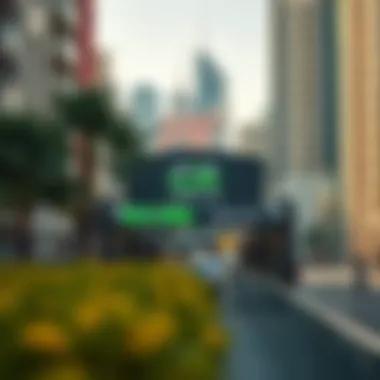

Such facilities do not just serve functionality; they also foster an environment where users feel cared for and valued, which can greatly influence their choice to live or work nearby.
Onboard Services
Once on board, the experience doesn't stop at just reaching the destination. The services offered during the ride can significantly enhance passenger satisfaction:
- Comfortable Seating: Trains are fitted with ergonomic seating arrangements, making sometimes lengthy commutes more tolerable. The seating layout promotes social interaction while also catering to personal space needs.
- Air Conditioning: Consistent temperature control is crucial in Dubai's climate, allowing for a pleasant ride irrespective of outdoor heat levels.
- Digital Connectivity: Many trains offer Wi-Fi access, allowing users to stay connected, whether they are working or scrolling through social media.
- Dedicated Spaces: Areas designated for strollers and wheelchairs ensure that all passengers have ample room to ride comfortably. This inclusion nurtures a sense of community among riders, making the travel experience less isolating.
In summary, the user experience on the Green Line is crafted to offer a holistic approach to commuting, focusing on convenience, comfort, and accessibility. For those in the real estate market, these factors can play a pivotal role in influencing buyer decisions and property value, creating a ripple effect that extends beyond the transit system to impact the surrounding neighborhoods.
"Well-designed transit facilities not only enhance user satisfaction but also contribute to the vibrancy of urban living spaces."
By recognizing and promoting the significance of these aspects, stakeholders can better appreciate the return on investment that a solid user experience can provide.
Future Developments and Expansion Plans
As cities grow and evolve, so do their transportation networks. The Dubai Metro, particularly the Green Line, has become a critical vein in the city’s transport matrix. The emphasis on future developments and expansion plans is central to understanding the enduring significance of this line. A robust and continually evolving metro system not only enhances accessibility but also caters to the increasing demands of a bustling population and a dynamic economy.
Projected New Stations
With Dubai’s skyline constantly reshaping itself, new metro stations are on the drawing board. The expansion of the Green Line anticipates adding several strategic stations to better serve the city.
Some of the projected new stations include:
- Al Quoz Station – This area is an emerging commercial hub, and the addition of a station here will support the local economy and encourage livability.
- Jumeirah Station – A proposed station near major tourist attractions would enhance access for visitors and residents alike.
- Deira Waterfront Station – As a burgeoning business district, this station would connect more people to the economic opportunities in the area.
These future stations not only offer expanded access but also improve the existing network's integration with other public transport options, enhancing overall mobility in Dubai. Each new addition is like a jigsaw piece that completes the broader transportation picture.
Long-Term Vision for the Metro Network
The long-term vision for Dubai’s metro system encapsulates the city’s ambition to remain at the forefront of modern urban transport solutions. The Metro network’s expansion is not merely about adding tracks and stations; it is about strategizing for a sustainable future that aligns with Dubai's broader developmental goals.
- Sustainability Focus: With a commitment to sustainability, the future metro plans include energy-efficient trains and eco-friendly station designs. Enhancing public transport means fewer cars on the road, which contributes to reduced emissions.
- Smart Integration: Long-term plans also talk about integrating technology for smoother operation. Imagine a scenario where real-time data informs passengers of the next trains, and mobile payments make commuting more efficient.
- Smart Growth: Future expansions are closely tied to urban development plans, particularly in promoting areas outside of traditional hubs. This will, in turn, stimulate investment in those neighborhoods, driving up property values and creating vibrant communities.
In essence, the trajectory of the Dubai Metro, particularly concerning the Green Line, reflects the city's ambitious plan to deliver a world-class transport solution. The investments made today are aimed at ensuring future generations have access to a transit system that is not just reactive but proactive in responding to the dynamic urban environment.
"Great cities depend on great transportation systems. The future of Dubai’s Metro will elevate the city in the eyes of investors and residents alike."
Resources for More Information
- Dubai Metro - Wikipedia
- Dubai Government - Public Transport
- Gulf News - Metro Updates
- Arabian Business - Metro Expansion
As the Green Line continues to develop, its influence on the urban fabric of Dubai remains undeniable. The commitment to transport innovation signifies a dedication to enhancing overall quality of life for all residents.
Ending
As we traverse through the comprehensive fabric of the Dubai Metro Green Line, it becomes clear that this network is more than just a means of transport; it represents a vibrant lifeline intricately woven into the urban landscape of Dubai. The Green Line's relevance cannot be overstated. It bridges crucial sectors and enhances accessibility, serving as a modern artery that enables ease of movement across the city. With the ever-growing population and the increasing demand for efficient public transportation, the role of the Green Line is poised to gain even more significance in the years to come.
Summary of Key Points
To encapsulate the vast details discussed throughout the article,
- The Dubai Metro Green Line connects major districts, enhancing commuter options.
- Each station serves unique neighborhoods that influence lifestyle choices and convenience.
- The synergy between the metro system and real estate development forms a robust economic framework, significantly elevating property values near stations.
- Future expansions of the Green Line indicate an ongoing commitment to sustainability and urban development.
These points highlight the intricate web of connections that the metro fosters, illustrating its influence on both daily life and the larger landscape.
Implications for Real Estate Market
The implications for the real estate market surrounding the Dubai Metro Green Line are profound. Proximity to metro stations translates into a competitive advantage for properties, often leading to increased demand. Investors seeking ripe opportunities are likely to focus on zones adjacent to stations like Burj Khalifa/Dubai Mall Station or Business Bay Station, where foot traffic and accessibility present attractive features.
Moreover, the strategic positioning of the metro enhances livability, pushing potential homebuyers and developers to prioritize these areas. The infrastructure encourages mixed-use developments, cultivating vibrant communities where residential, commercial, and recreational spaces coexist.
In the fast-paced world of Dubai's real estate dynamics, understanding the Green Line's influence can position stakeholders to make informed decisions, ultimately leading to strategic investments that align with future growth trajectories.
"Public transport is not just about transport; it's about creating communities, fostering sustainable cities, and enabling economic growth."
Thus, analyzing the Green Line’s role provides essential insights into how urban planning elements can mold economic realities and lifestyle choices in one of the world's most dynamic cities.


